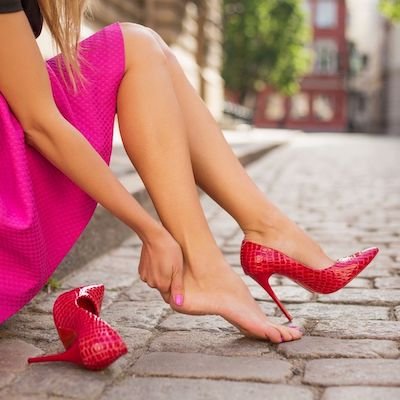Do Yourself a Favor and Put Those Stilettos Away
Did you know that high heeled shoes were first created as a fashion statement for men, not women? Originally designed with a much lower, wider heel than we're used to seeing today, they were intended to provide height that would indicate class, power, and privilege. Soon adopted by women, they quickly became a status symbol: the higher a woman's shoe was, the longer her dress had to be, and the more expensive fabric it required. In time, high heels became almost exclusively the domain of women's fashion. In the mid-20th century, styles changed once again. New technology made the production of the stiletto heels that we see today possible. A new look was in vogue and, with it, the new problem's for women's feet.
Today, almost three-quarters of women wear high heels. Most choose them for parties and special occasions, but many wear them daily. These shoes take the body out of its natural anatomical alignment. High heels force women to walk in a way that adds stress to the feet, ankles, hips, and back. The long-term result of this constant misalignment can be pain from head to toe. Further, most stilettos incorporate a cramped, narrow toe box that contributes to a variety of foot deformities. Patients often come to our office with preventable problems directly related to high heeled shoes:
Foot and Ankle Injuries: High heels decrease the amount of the sole that is in contact with the ground, diminishing balance and increasing the risk of falls.
Heel Pain: Stilettos cause increased stress along the sole of the foot and are believed to directly contribute to plantar fasciitis.
Sciatica: Patients who prefer high heeled shoes often report numbness, tingling, muscle weakness, spasms, cramping and pain that radiates through the buttocks and down the legs.
Bunions: Long-time high heel aficionados often suffer from bony bumps at the base of the big toe that protrude out of the side of the foot, causing pain and making it hard to wear any shoes comfortably.
Corns and Calluses: Unnatural, extreme pressure can create painful accumulations of dead skin cells that require medical attention.
For the sake of your feet, it's time to retire those high heels. If you're not quite ready to give them up entirely, consider saving them for parties and special events. For everyday use, look for comfortable shoes made of breathable material that gives your toes room to wiggle a bit. Heels should be low and chunky, and soles made of rubber for maximum traction.
Contact James C. Ricketti, DPM and let us address all your foot and ankle needs. Our board-certified podiatrist will tailor treatments based on your individual needs and with our state-of-the-art diagnostic and treatment options, we’ll help you get back on your feet in no time! Call our office today at 609-587-1674 to make an appointment at our conveniently located Hamilton, NJ office.
